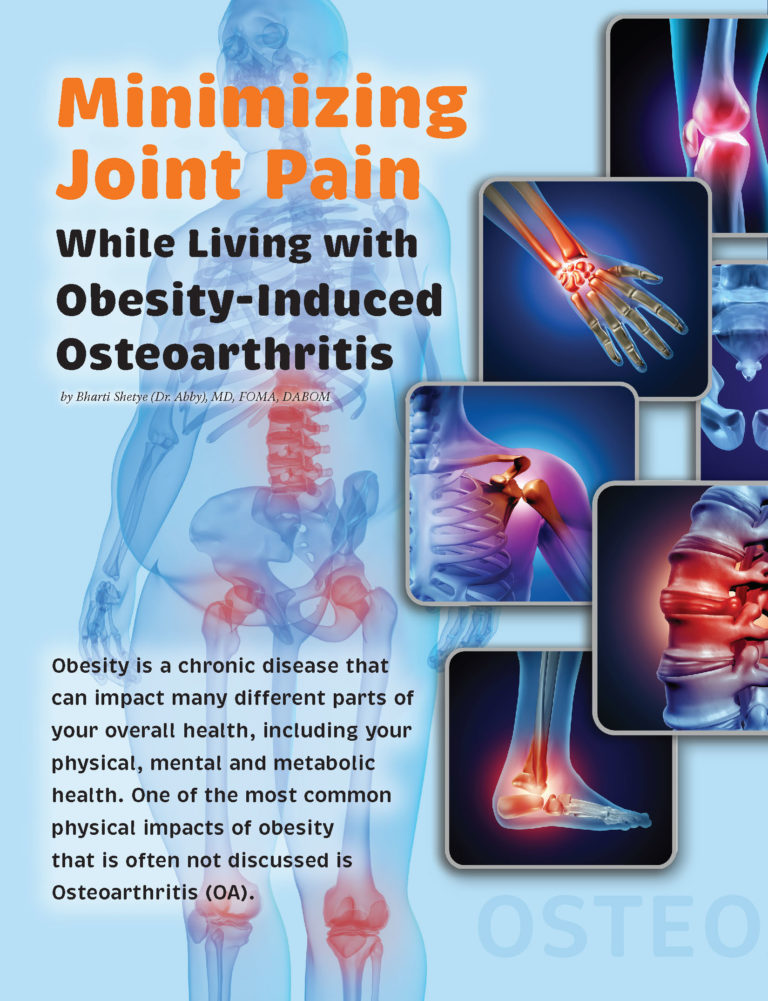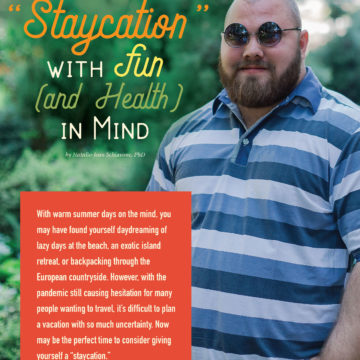Minimizing Joint Pain While Living with Obesity-Induced Osteoarthritis


by Bharti Shetye (Dr. Abby), MD, FOMA, DABOM
Summer 2021
Obesity is a chronic disease that can impact many different parts of your overall health, including your physical, mental and metabolic health. One of the most common physical impacts of obesity that is often not discussed is Osteoarthritis (OA).
What is Osteoarthritis and How Does Obesity Affect it?
Osteoarthritis (OA) is the most common form of arthritis, a serious chronic disease that affects one in seven adults and is a leading cause of disability among older adults. The knees, hips and hands are the most commonly affected joints in OA.
OA is characterized by the wearing down of the protective tissue at the ends of bones (cartilage). It occurs gradually and worsens with time, leading to pain, stiffness, swelling, loss of normal joint function and impaired mobility. This limits the ability to perform routine tasks such as holding a cup of water or walking.
Obesity-induced OA was previously thought to only be related to the fact that excess weight often wears and tears on cartilage. We now know that a number of inflammatory mediators produced in fat affect joint tissues and play a role in pain. Essentially, the body can produce proteins from inflammation that cause damage in the body and are associated with OA.
How Can I Help Relieve Joint Pain?
There are many ways to reduce joint pain if you live with obesity-induced OA, including medical treatments and physical treatments. Sometimes, both medical and physical treatments will be used in combination to relieve joint pain.
*Disclaimer: Before participating in exercise or taking medication, contact your healthcare provider to learn if this is the right treatment for you.
Types of Physical Treatments
Low-Impact Exercises
This is a great starting point for many people who are affected by both obesity and OA because you can go at your own pace and pick any exercise you enjoy. Whether it is strength training, cardio, aerobic activity or balance exercises, any type of exercise can help relieve joint pain.
Mind-Body Practices
Mind and body practices such as tai chi or yoga combine meditation with slow, gentle, graceful movements that are found to be extremely relaxing and overall good for your health. They have a holistic impact on strength, balance and targeting pain in the body.
Acupuncture
Research has found that inserting an acupuncture needle activates the production of cortisol, a hormone that helps control inflammation in the body. It has also been proven to stimulate activity in other pain-relieving chemicals throughout the body.
Physical and Occupational Therapy
Physical and occupational therapy are extremely beneficial to patients with arthritis. Occupational therapists can show you how to modify your home and workplace environments to reduce conditions that may aggravate arthritis. They can also recommend and provide assistive devices such as splints and knee braces to help with tasks like driving, bathing, dressing, housekeeping and walking.
Physical therapists will work with you to increase the range of motion of a joint so that you are able to build strength around the muscles that surround the joint. Stronger muscles can better stabilize a weakened joint.
Types of Medical Treatments
Topical NSAIDs
Topical non-steroidal anti-inflammatory drugs (NSAIDs) are strongly recommended for use in knee OA patients with no comorbidities. The negative effects from topical NSAIDs are minimal and mild. The most common negative effects are local skin reactions, which are minor and short-term.
Oral NSAIDs
Oral NSAIDs, such as ibuprofen or Advil, are commonly recommended for managing OA. There are many different negative effects depending on the oral medication chosen, so always talk with your doctor before beginning an oral NSAID.
Intra-articular Corticosteroids (IACS) and Hyaluronan (IAHA) Injections
IACS injections provide short-term pain relief and are usually recommended when topical and oral medications are not working. It is a shot that is placed directly into the joint and is commonly used for people who have knee or hip OA.
While IACS injections provide on-the-spot pain relief, IAHA injections may have beneficial effects on pain at and beyond 12 weeks of treatment. IAHA injections are a more favorable treatment option because they are safer than repeated IACS injections.
Acetaminophen
Acetaminophen is used to relieve pain from OA by changing the way the body senses pain and cooling the body. It is most likely recommended to people who have not found any relief from topical or oral NSAIDs.
Duloxetine
Duloxetine is normally used to treat depression and anxiety. However, it has been found to be useful in treating different types of pain.
Duloxetine is recommended as a treatment for OA if the patient has not responded to acetaminophen or NSAIDS. It is NOT used to treat inflammatory arthritis.
Tramadol
Tramadol is an alternative treatment option for OA. This opioid is used on people who have failed treatment with acetaminophen and NSAIDs.
Conclusion
With so many different treatment options available to people suffering from OA, it is crucial that you talk with your healthcare provider before beginning any treatment plan. Every treatment is different and it is important that you find the safest and most effective option for you.
About the Author:
Bharti Shetye (Dr. Abby), MD, FOMA, DABOM, is an internist practicing obesity medicine in St. Petersburg, FL. She is an advocate for the Obesity Action Coalition (OAC) and has visited Capitol Hill to speak with United States legislators about supporting the Treat and Reduce Obesity Act. Her own struggles with weight pushed her to want to help patients and provide them with the necessary resources, support and advocacy they need. She often volunteers for the Obesity Medicine Association (OMA) and in her free time she enjoys exercising and exploring her own healthy lifestyle.
by Yelena Kibasova Spring 2024 The fitness world is evolving, with new trends and innovations that promise…
Read Articleby Zack Lucks, NASM-CPT, EMT Winter 2024 Working out with a loved one is a great way…
Read Articleby Nina Crowley, PhD, RD (with Inspiration from Shawn Cochran) Winter 2024 Dating, no matter your age,…
Read Article








